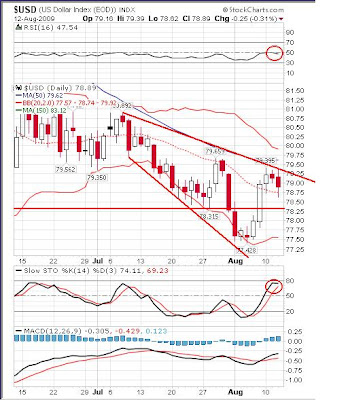Another FOMC meeting. Another "stay the course" commitment. Below is today's FOMC official statement. What we believe to be key points are bolded.
Federal Reserve Press Release
Release Date: August 12, 2009
For immediate release
Information received since the Federal Open Market Committee met in June suggests that economic activity is leveling out. Conditions in financial markets have improved further in recent weeks. Household spending has continued to show signs of stabilizing but remains constrained by ongoing job losses, sluggish income growth, lower housing wealth, and tight credit. Businesses are still cutting back on fixed investment and staffing but are making progress in bringing inventory stocks into better alignment with sales. Although economic activity is likely to remain weak for a time, the Committee continues to anticipate that policy actions to stabilize financial markets and institutions, fiscal and monetary stimulus, and market forces will contribute to a gradual resumption of sustainable economic growth in a context of price stability.
The prices of energy and other commodities have risen of late. However, substantial resource slack is likely to dampen cost pressures, and the Committee expects that inflation will remain subdued for some time.
In these circumstances, the Federal Reserve will employ all available tools to promote economic recovery and to preserve price stability. The Committee will maintain the target range for the federal funds rate at 0 to 1/4 percent and continues to anticipate that economic conditions are likely to warrant exceptionally low levels of the federal funds rate for an extended period. As previously announced, to provide support to mortgage lending and housing markets and to improve overall conditions in private credit markets, the Federal Reserve will purchase a total of up to $1.25 trillion of agency mortgage-backed securities and up to $200 billion of agency debt by the end of the year. In addition, the Federal Reserve is in the process of buying $300 billion of Treasury securities. To promote a smooth transition in markets as these purchases of Treasury securities are completed, the Committee has decided to gradually slow the pace of these transactions and anticipates that the full amount will be purchased by the end of October. The Committee will continue to evaluate the timing and overall amounts of its purchases of securities in light of the evolving economic outlook and conditions in financial markets. The Federal Reserve is monitoring the size and composition of its balance sheet and will make adjustments to its credit and liquidity programs as warranted.
Voting for the FOMC monetary policy action were: Ben S. Bernanke, Chairman; William C. Dudley, Vice Chairman; Elizabeth A. Duke; Charles L. Evans; Donald L. Kohn; Jeffrey M. Lacker; Dennis P. Lockhart; Daniel K. Tarullo; Kevin M. Warsh; and Janet L. Yellen.
Let's boil this down to facts and conjecture, shall we?
The situation according to the Fed [with our comments in brackets]:
- Spending is stabilizing. [Of course it's stabilizing. People have stopped living outside their means as much, but they have to buy things to survive. That can't go away without some serious side effects...]
- Job and income loss, tight credit, and business cut backs continue.
- Businesses will cut back their size to reflect their sales [Prospectively sales to people that have no jobs, income, or credit? We suspect that the cut backs are not close to done to reflect the new economic reality of much less consumption moving forward.]
- We are in a business inventory restocking phase. [That would a cyclical bull within a secular bear that we've been discussing as a possibility.]
- Economic activity will remain weak for a time. [Probably until we start producing more than we consume so that wages in real terms rise instead of fall. This is not a short term process.]
- The basics of life have gotten more expensive, but don't fret. The Fed believes they won't continue to rise [This is the same Fed that doesn't really understand inflation, isn't it? They must manage your perception--keep you believing that prices aren't rising while they are. Goebbels would be proud.]
The solution according to the Fed [with our comments in brackets]:
- Interest rates near zero [Since consumers can't borrow because they're generally already in too much debt with their housing asset values in the toilet, why do we need cheap credit? Oh wait, the banks need to borrow at zero percent and speculate in the markets, buy Treasuries, and make loans at much higher rates so they can stay alive. How could we possibly forget??]
- Buying more agency and agency-backed securities. [There are no other buyers for these ticking time bombs, so the Fed is the buyer of last resort. These will, of course, be bought with money out of thin air since the Fed must create money to buy things.]
- Finishing buying Treasuries by end of October [with newly minted money. But note they leave the door open to continue if warranted. Since the foreign buyers have been drying up, they'll probably have to buy more later on.]
In short, we have a massive debt bubble. It was created by inflation that eroded real wages over the years. So once peoples' money was devalued beyond their ability to live the same or better lifestyle, they had to borrow to continue on. Now they can no longer borrow because the house of cards is falling apart. But, the solution to this problem, according to the Fed, is to push more credit and money into the markets, which of course is the very source of the problem.
It's akin to trying to extinguish a fire with gasoline. It probably won't end well.
Remember, they can only manage your expectations. They cannot stop reality from occurring. You must be aware of what's happening and continue to stay on top of events. Your future depends on it.
We are far from the end of all of this, though the worst is still ahead.
Read more...








